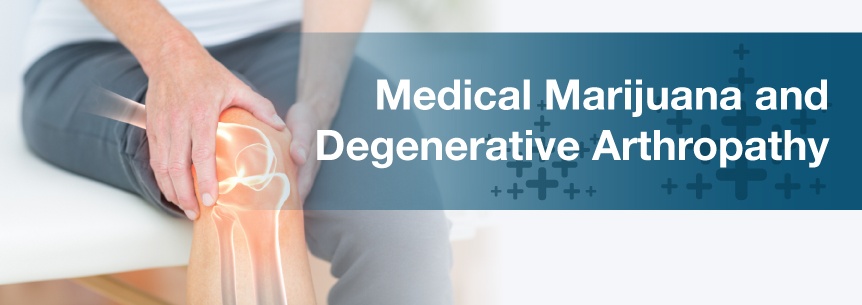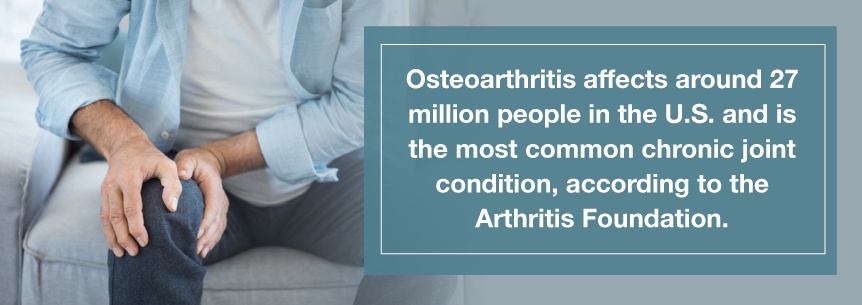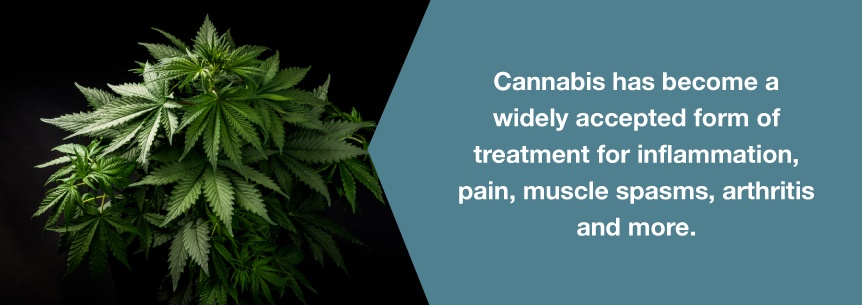
Degenerative arthropathy is a challenging condition to live with. Simple tasks like walking, standing up and opening a jar can feel unbearable because of the pain corresponding with the condition. Only some treatments provide sufferers with effective relief, so they turn to addictive pain relievers, anti-inflammatories and even surgery. Fortunately, medical marijuana for degenerative arthropathy can help.
Degenerative arthropathy, also called degenerative joint disease or osteoarthritis (OA), is a condition your body may develop as it wears through the aging process. If you have this disorder, you might feel neck or back pain or stiffness in your joints when trying to move in a certain fashion.
You might experience degenerative arthropathy if you have a single joint trauma, such as with an acute shoulder dislocation or with an intra-articular or periarticular fracture — healing has taken place in or around your joint. This situation is called post-traumatic arthritis.
OA affects around 27 million people in the U.S. and is the most common chronic joint condition, according to the Arthritis Foundation.

It can occur in your:
In normal joints, you have a rubbery, firm material called cartilage covering the end of each of your bones. Your cartilage offers a smooth, gliding surface for moving your joints and works like a cushion between your bones. With osteoarthritis, your cartilage begins breaking down and causes swelling, pain and issues moving your joint.
As your arthritic condition becomes worse, you develop growths known as spurs, and your bones might break down. You may have bits of cartilage or bone that chip off and begin floating in your joint. An inflammatory process occurs in your body, and proteins and enzymes develop, furthering cartilage damage. Your cartilage wears away in the final phases of OA, and bone rubs against bone, leading to more pain and joint damage.
Degenerative arthropathy symptoms occur due to gradual articular cartilage deterioration on joint surfaces. Your cartilage protects your joints, allowing them to move easily. When you don’t have articular cartilage, the joint surfaces become raw and abrade each other, rapidly eroding away.
Although symptoms of this condition can vary, many individuals with degenerative arthropathy experience:
The position of your affected spinal joints will determine the area of these symptoms. You may experience discomfort in your:
Degenerative arthropathy in your spine affects your facet joints. These are your joints located on both sides of your vertebrae, allowing your spine to twist and bend. A thin layer of cartilage lines these joints and the joints are also covered with a type of thick lubricating fluid, allowing your adjacent vertebrae to glide against each other comfortably and gently.
When you have OA in your spine, or facet disease, your cartilage wears away and causes your vertebral joints to begin rubbing together. When this occurs, it can cause localized pain, inflammation and various other symptoms.
Degenerative arthropathy is generally the result of many years of wear and tear taking their toll on your joints. Certain factors can accelerate this process, such as:
You can develop arthritis in any joint of your body, but it’s more common in the lower back and neck, since these areas are incredibly flexible and overloaded with the job of supporting your body weight.
Usually, the effects of this condition gradually develop and seem to be worse after long periods of inactivity or in the early morning. However, OA can eventually get to where moving your joints is not only difficult, it often seems impossible — and this can affect your quality of life.
There are several types of degenerative joint disease, but the two most common are osteoarthritis and rheumatoid arthritis.
The condition can affect any joint in your body, but the hips, knees, spine and other weight-bearing joints are most susceptible.
When degenerative arthropathy affects your back and neck, it’s called spinal osteoarthritis or facet disease. Your facet joints connect your vertebrae, which allow your spine to flex and bend. But, with age, they begin drying out and the cartilage lining starts to become brittle and could wear away. When you don’t have a protective lining, bone rubs against bone and causes bone spurs, inflammation and nerve compression.
OA is a degenerative disease that becomes worse over time. Stiffness and pain in the joints can become so severe, it makes everyday activities challenging to perform. Some individuals can’t work any longer. Other complications you might experience with this condition are:
Depression and anxiety affect OA patients’ quality of life. Caregivers and doctors should consider the comorbidities in OA patients. And, to improve patient outcomes, a holistic, individualized management treatment is best.
Facts about the condition, according to the Centers for Disease Control and Prevention (CDC), include:
OA’s been around for many, many years — centuries, even. In fact, it’s gone back as far as the Egyptian mummies and skeletons in England. W.P. May described one example of OA in 1897 in an Egyptian mummy with rheumatoid arthritis. Typically, these ancient people had OA of the shoulders and degenerative changes in their lumbar spine. Few had it in their knee joints.
The first joint replacement surgery didn’t take place until 1940, when Dr. Austin Moore treated a patient with degenerative arthritis with a metallic hip replacement surgery. And, although materials and methods have changed, the standard for severe hip OA is still hip arthroplasty.
Degenerative joint disease doesn’t have a cure. However, many individuals can ease their symptoms without surgery through conservative therapies. Your doctor will sit down with you and discuss a treatment plan that could include:
You can reduce pain and ease the burden on your joints through muscle-building exercises around your joints. Reduce stiffness and improve and maintain joint flexibility with range-of-motion exercises. Improve energy levels and stamina with aerobic exercise, which also helps reduce extra weight.
The CDC recommends all people, even those who have arthritis, participate in at least 150 minutes of moderate exercise every week.

Weight-bearing joints like your knees, hips, back and feet suffer additional stress with excess weight. Therefore, losing weight can help individuals with OA limit further joint damage and reduce pain. To lose weight, you need to increase physical activity and eat fewer calories.
Gentle and slow stretching of your joints can help lessen stiffness, improve flexibility and reduce pain. Tai chi and yoga are good examples of exercises to manage stiffness.
Medications for degenerative arthropathy come in forms like creams, pills, lotions and syrups. The doctor can also inject them into your joint. Here are some examples.
Pain medications like opioids, acetaminophen and tramadol are available either by prescription or OTC. Side effects of analgesics may include:
These drugs help treat inflammation and related pain. They include ibuprofen, aspirin, celecoxib and naproxen, and come by prescription or OTC. Some side effects may include:
Hyaluronic acid naturally occurs in the fluid of the joint and acts as a lubricant and shock absorber. However, this acid seems to break down in individuals with OA. Injections take place right in your doctor’s office. Side effects may include:
These are strong anti-inflammatory medications. You take them orally, or the doctor can inject them into your joint directly. When using oral corticosteroids for more than three months, side effects can occur like:
Both occupational and physical therapists can help manage your pain through a range of treatment approaches such as:
Surgeons can replace or repair severely damaged joints through joint surgery.
Scientists have identified various new treatment developments for treating and preventing OA. One 2012 study showed OA patients reported improved pain scores with a single zoledronic acid infusion. MRI scans showed the patients’ bone marrow lesions reduced in size.
The University of Southern California’s Keck School of Medicine researchers made a molecule that could treat arthritis down the road. When the doctor injects the molecule into an arthritic joint, it could trigger cartilage regeneration and render arthroplasty unneeded.
Cannabis has become a widely accepted form of treatment for inflammation, pain, muscle spasms, arthritis and more.

Medical marijuana and degenerative arthropathy has active, chemical compounds known as cannabinoids that have medicinal properties. These cannabinoids are what helps treat those and other symptoms. When you ingest them, they interact with different body receptors, particularly your natural cannabinoid receptors.
Some of these compounds have scientific medical value for pain relief. The cannabinoids CBD, CBN, CBC and THC are all associated with arthritis and pain relief, and can help with inflammation, spinal injury, fibromyalgia and more.
Aside from stiff, aching joints, degenerative arthropathy can also produce symptoms such as:
Marijuana for degenerative arthropathy can help with all these.
People who struggle with chronic arthritic pain also deal with inflammation of their joints. They find relief through the use of CBD oil, which can reduce and sometimes completely eliminates their pain and inflammation. Freedom from discomfort allows them to enjoy the activities they once loved. They are no longer stuck in the house avoiding the pain that arises with activity, and can spend time with their loved ones.
Marijuana can have side effects, however, depending on the strain and dosage. These can include giddiness, panic attacks, hunger, drowsiness, impaired reaction times, red eyes and dry mouth, to name some of the most common.
Here are some potentially beneficial medical cannabis for degenerative arthropathy strains.
There are a few ways you can take marijuana and degenerative arthropathy treatment. While you can always smoke it through a bong or joint, bake it into edibles like brownies, cookies or cake or ingest it using a mouth spray, below is what many patients with OA are finding most effective.
Even though cannabis can still treat your symptoms effectively when you smoke or vaporize it, using it as a topical may work best. That makes sense, since arthritis tends to afflict localized pain, and applying it directly to your skin targets the pain.

Some choices of topicals are:
Cannabis-infused topicals have already provided relief to many individuals with eczema, psoriasis and arthritis. Therefore, it’s not surprising it can help with degenerative arthropathy as well.
Some individuals, as well as cannabis for degenerative arthropathy treatment advocates, have recommended juicing the raw leaves of the plant. With juicing, you’ll benefit from a lesser-known cannabinoid called THC-A. This compound turns into THC when you apply heat through smoking or vaping, making it an acidic precursor. It also turns into THC due to exposure to oxidation and light after a period.
If you’d like more information about cannabis and degenerative arthropathy treatment or would like to try it to see if it will relieve your inflammation, pain, stiffness and other arthritic symptoms, book your appointment to speak with a qualified cannabis doctor through MarijuanaDoctors.com. We also have an extensive list of marijuana dispensaries you can choose from for your cannabis products. All of us here at MarijuanaDoctors.com dedicate our efforts to improving your quality of life.
Find A Doctor Find A Dispensary